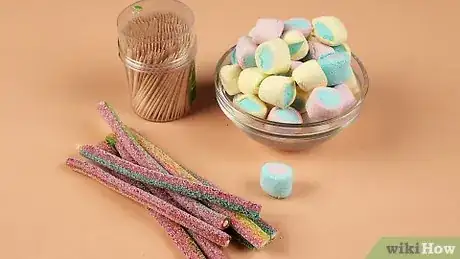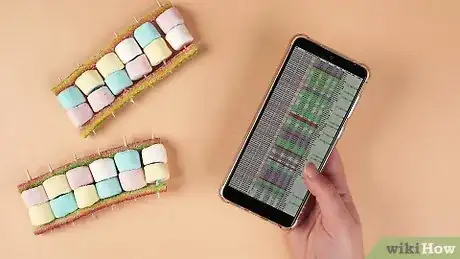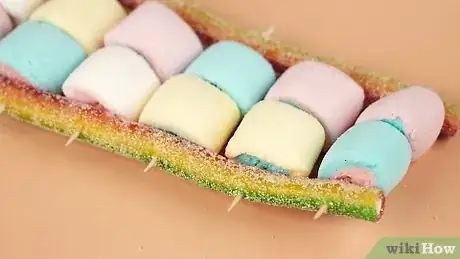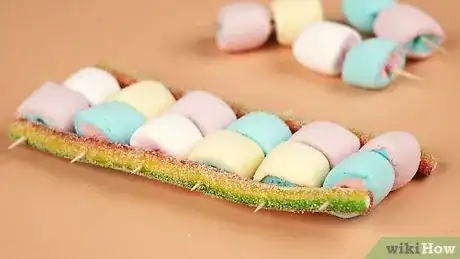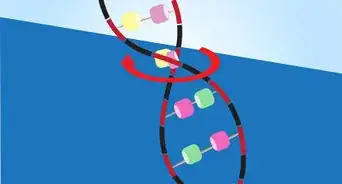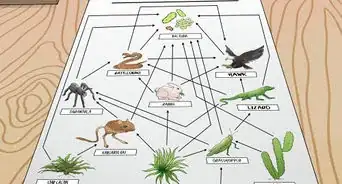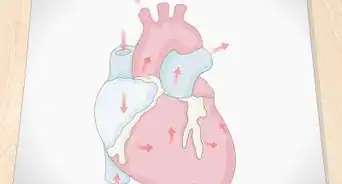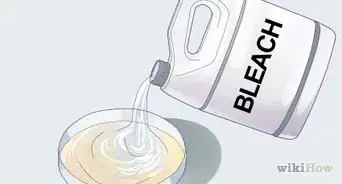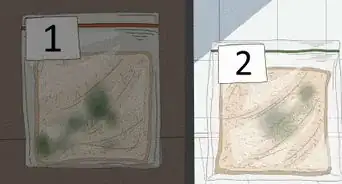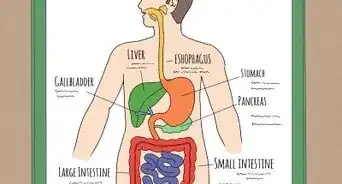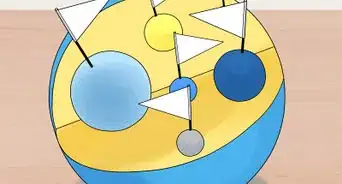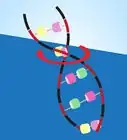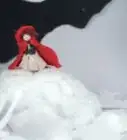This article was co-authored by Bess Ruff, MA. Bess Ruff is a Geography PhD student at Florida State University. She received her MA in Environmental Science and Management from the University of California, Santa Barbara in 2016. She has conducted survey work for marine spatial planning projects in the Caribbean and provided research support as a graduate fellow for the Sustainable Fisheries Group.
There are 8 references cited in this article, which can be found at the bottom of the page.
This article has been viewed 84,953 times.
Deoxyribonucleic acid (DNA) is the basic building block of human nature. With advances in genetics, biology has become one of the most important, cutting-edge fields in science.[1] It is more important than ever before that we begin familiarizing ourselves with DNA at a young age, and what better way to do it than by making an educational snack?
Steps
Making the DNA Model
-
1Prep your workspace. Clean and sanitize a table that has enough surface space for you to construct the helix; you do want to be able to eat the DNA afterward. Collect the necessary supplies including tooth picks, a bag of candies with 4 different colors, and, if possible, licorice sticks.
- There are limitless number of food items that can be used to represent the DNA, it just need to be color coded and soft enough to put a toothpick through. Colored marshmallows are a popular option, as are gummies.[2] For a healthier option chop up 4 types of fruit, like strawberries, bananas, grapes, and pineapples.
-
2Make a color key. Each of the color-coded items represents one of the 4 chemicals that make up the DNA code: Guanine, Adenine, Cytosine, and Thymine. It is important to decide in advance which marshmallows (or fruits or candies) represent which chemicals, because the chemicals bond in specific ways.Advertisement
-
3Start building your bases. Use the toothpicks to connect the marshmallows, candies, or fruits into pairs. Poke the toothpick through 2 marshmallows so that they are firmly stuck together. Remember, that in nature only 2 types of bonds are possible. Guanine must bond with Cytosine and Adenine must bond with Thymine. Consult your color key to verify that you aren’t breaking this pattern.
- Push the marshmallows close to one another on the toothpick so that there is plenty of space on the ends of the toothpick left to attach licorice.
- You should repeat this process to create approximately 6 base pairs.
- Base pairs can be arranged in any order. However, you should have at least 1 of each type of base pair for the sake of the project.[3]
-
4Connect your bases to the backbone. The backbone is what holds the bases together into a single strand of DNA. Take the toothpicks with the marshmallows bases and poke the end of the toothpicks through a stick of licorice on each end of the base pair.
- You should also aim to make a ladder shape, taking several base pairs and lying them next to one another to form a line of parallel bases. If you don’t want to use licorice, you can also connect the bases to one another with toothpicks. Insert toothpicks into the top of the marshmallow on each side of the base, connecting it to the bottom of the marshmallow on the next base. Repeat until all of the bases are connected.[4]
-
5Twist the licorice. Once you have connected enough bases that it resembles a ladder, twist the licorice so that it looks like a “double helix” or a spiral staircase. This is the shape that DNA takes in the real world.
Learning from Candy
-
1Check that the model is right. Review the color key to see if the bases are properly bonded. Remember, Adenine should pair with Thymine and Cytosine should pair with Guanine. If Thymine is bonded with Cytosine or Adenine with Guanine, the model is wrong, because these nucleotides cannot form a hydrogen bond with each other.[5]
- Remember, that the order of base pairs forms a code that tells your body how to work. Think of these 2 bonds as somewhat like binary code--the system of zeros (0) and ones (1) that tells your computer what to do.
-
2Compare DNA. If several students have made DNA together, have them compare what they made. See how they differ. Remind your students that an actual human gene can have as many as 2,000,000 base pairs.[6] Explain that the differences they see in their model DNA grow as a strand reaches 2,000,000 base pairs, so that these strands can store an incredible amount of information, enough to make each person in the classroom unique and different from their peers.
- If you have done the project alone, you can also make multiple strands and compare them to each other. Consider how many different arrangements are possible.
-
3Remember the backbone. The backbone of the DNA, in this case represented by the licorice, is easy to forget about because it doesn't store any information. However, as the name suggests, it holds the whole thing together. The backbone is composed of a sugar, deoxyribose, bonded with a phosphate group.[7] These give structure to the DNA.
-
4Look at your own DNA. Build a checklist of genetic traits and have students compare their DNA to another student in the classroom or to their parents. Some genetic traits that you can compare include: eye color, hair color, dimples, dominant hands, freckles, curliness of hair, and color blindness.[8]
-
5Chow down. Remember, science isn’t just about abstract ideas; it’s about making our lives better. Science puts food on our table every day. What better way to realize the practical benefits of science than to eat it in all of its glorious sweetness? Edible DNA was literally made to be eaten.
Community Q&A
-
QuestionHow can I make it stand upright?
 Community AnswerYou can use wooden dowels or other pieces that are sturdy to help it stand upright.
Community AnswerYou can use wooden dowels or other pieces that are sturdy to help it stand upright. -
QuestionHow do you keep the Twizzlers in that twisted shape?
 Community AnswerBy wrapping them onto marshmallows behind the model. Doing this would cause a more structured model than just having it on the sides.
Community AnswerBy wrapping them onto marshmallows behind the model. Doing this would cause a more structured model than just having it on the sides.
References
- ↑ https://www.lifeknowledgepark.org.uk//
- ↑ https://www.ndsu.edu/pubweb/~mcclean/plsc731/Genome-sequencing-PMG-overheads.pdf
- ↑ https://www.uc.edu/content/dam/refresh/cont-ed-62/olli/s21/kahn-evidence-of-evolution.pdf
- ↑ https://www.youtube.com/watch?v=YE5p1ndsCr0
- ↑ https://medlineplus.gov/genetics/
- ↑ https://www.youtube.com/watch?v=UhxqQ550L9s
- ↑ https://www.chemguide.co.uk/organicprops/aminoacids/dna1.html
- ↑ https://www.youtube.com/watch?v=L3z0mEmHOkE/
